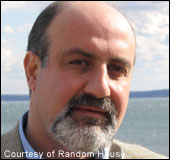Nassim Taleb has released a technical note for Antifragile on his Facebook Page: Why the One Percent of the One Percent benefit from inequality more than general prosperity: A Note for AntiFragile.
Excerpt:
Introduction
The one percent of the one percent of the population is vastly more sensitive to inequality than total GDP growth (which explains why the superrich are doing well now, and should do better under globalization, and why it is a segment that doesn’t correlate well with the economy). For the super-rich, one point of GINI causes an increase equivalent to 6-10% increase in total income (say, GDP). More generally, the partial expectation in the tail is vastly more sensitive to changes in scale of the distribution than in its centering.
Sellers of luxury goods and products for the superwealthy profit from dispersion more than increase in total wealth or income. I looked at their case as a long optionality, benefit-from-volatility type of industry.
From Antifragile:
Another business that does not care about the average but rather the dispersion around the average is the luxury goods industry—jewelry, watches, art, expensive apartments in fancy locations, expensive collec – tor wines, gourmet farm – raised probiotic dog food, etc. Such businesses only cares about the pool of funds available to the very rich. If the population in the Western world had an average income of fifty thousand dollars, with no inequality at all, the luxury goods sellers would not survive. But if the average stays the same, with a high degree of inequality, with some incomes higher than two million dollars, and potentially some incomes higher than ten million, then the business has plenty of customers—even if such high incomes were offset with masses of people with lower incomes. The “tails” of the distribution on the higher end of the income brackets, the extreme, are much more determined by changes in inequality than changes in the average. It gains from dispersion, hence is antifragile.
This explains the bubble in real estate prices in Central London, determined by inequality in Russia and the Arabian Gulf and totally independent of the real estate dynamics in Britain. Some apartments, those for the very rich, sell for twenty times the average per square foot of a building a few blocks away.
Harvard’ s former president Larry Summers got in trouble explaining a version of the point and lost his job in the aftermath of the uproar. He was trying to say that males and females have equal intelligence, but the male population has more variations and dispersion (hence volatility), with more highly unintelligent men, and more highly intelligent ones. For Summers, this explained why men were overrepresented in the sci – entific and intellectual community (and also why men were overrepre – sented in jails or failures). The number of successful scientists depends on the “tails,” the extremes, rather than the average. Just as an option does not care about the adverse outcomes, or an author does not care about the haters.
Link: http: // www. fooled by randomness. com/ Onepercent. pdf


